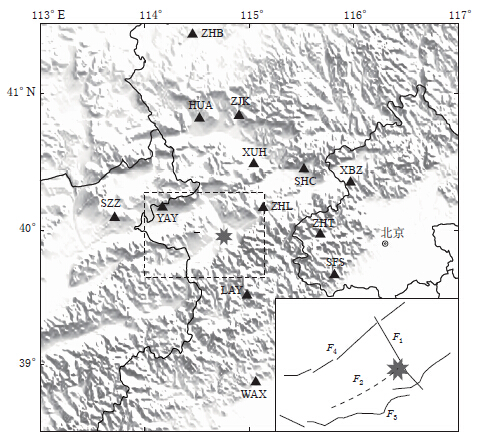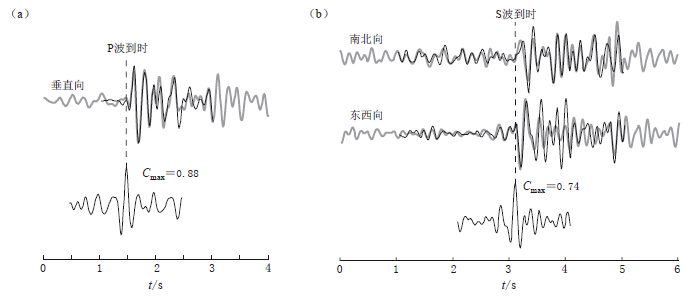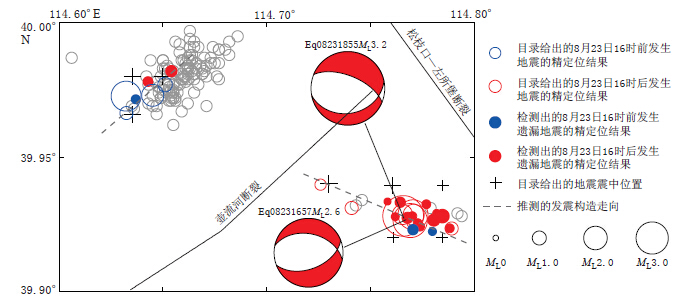Missing earthquakes detection and seismogenic structure of the Yuxian earthquake swarm in August of 2013
-
摘要: 华北地区近年来小震群活动频繁, 在有数字波形记录的中强地震相对缺乏的背景下, 小震群发震构造精细研究可为华北地区地震危险性分析和地震趋势判断提供重要依据. 本文利用匹配滤波技术对2013年8月22—25日河北蔚县小震群遗漏地震事件进行检测, 并通过地震精定位和震源机制求解分析此次震群的发震构造. 计算结果显示, 通过互相关扫描检测到18次被地震台网常规分析遗漏的地震, 约为地震目录给出的13次地震事件的1.38倍. 该震群发震构造有北东向和北西向两组断裂, 震群活动前期以北东向构造活动为主, 后期地震主要发生在北西向构造, 北西向构造在此次震群活动中地震频度和强度均高于北东向构造. 震源机制计算结果显示北西向构造发震机制以正断拉张为主.Abstract: The increasing seismicity of small earthquake swarms have been observed in North China area during recent years. Due to the lack of digital waveform recordings of large earthquakes in this area, detailed seismogenic structure analysis of earthquake swarms is of significance to seismic risk analysis and earthquake tendency judgement. We herein used matched filter technique to detect missing earthquakes in Yuxian small earthquake swarm occurred during August 22nd to 25th, 2013. By the technique we detected 18 missing earthquakes, which are about 1.38 times of 13 listed in the catalog. The seismogenic structure of the earthquake swarm can be divided into two parts. One is an NE-trending fault and more active in the early time of this earthquake swarm; the other is an NW-trending fault on which more earthquakes occurred in the later time. The seismicity is much stronger in the NW-trending fault than that in the NE-trending fault. According to focal mechanism of two lager earthquakes in the swarm, it is suggested that the mechanism of earthquakes occurred on the NW-trending fault are dominated by normal slip.
-
-
图 1 蔚县震群观测台站(三角形)和震中位置(八角形). 右下角为震中周边主要断层的分布示意图F1: 松枝口—左所堡断裂;F2: 壶流河断裂;F3: 蔚广盆地南缘断裂;F4: 六棱山北麓断裂
Figure 1. Epicenter of Yuxian earthquake swarm,seismic stations and faults distribution of Yuguang basin The lower right corner gives the distribution of main faults surrounding the earthquake swarm. Triangles are stations used in this paper,and the octagon is the epicenter location of the swarm. F1: Songzhikou- -Zuosuobao fault; F2: Huliuhe fault; F3: Yuguang basin south edge fault; F4: Liulengshan north edge fault. Dashed line denotes buried fault
图 3 利用波形互相关震相检测技术搜索遗漏地震事件P波、S波到时方法示意图灰色表示连续波形,黑色表示波形模板.波形模板为事件Eq08231657涞源台(LAY)记录,扫描出遗漏地震发震时刻为2013-08-24 13:38:37.92.波形经过4阶零相移Butterworth滤波器2—8 Hz滤波;地震波形下方为波形互相关系数,标注互相关最大值Cmax(a)通过垂直向波形互相关检测P波到时;(b)通过水平向波形互相关检测S波到时
Figure 3. Detecting the P- and S-wave arrival times of missing events using cross-correlation phase detection technique. Gray curves are continuous waveforms filtered in 2—8 Hz by 4th-order zero-phase Butterworth filter,black curves are filtered template waveforms. Template is the waveform recording of Eq08231657 from LAY station,origin time of the missing event is 2013-08-24 13:38:37.92.The curve below the waveforms is cross-correlation coefficient sequence,and its maximum value(Cmax)is indicated.(a)P-wave wavefrom of vertical component;(b)S-wave wavefrom of two horizontal components added
图 6 蔚县震群地震精定位及震源机制结果图灰色空心圆为2008年1月至蔚县震群发生前震群所在区域发生的地震
Figure 6. Relocation result and focal mechanics of Yuxian earthquake swarm Open circles represent catalog events,solid circles represent detected missing events in this study,blue and red open circles represent the earthquake occurred before and after 16:00 on August 23rd,respectively. Gray circles are earthquakes from January,2008 to August 21st,2013. Black crosses are the epicenters of earthquakes in the catalog,dashed lines indicate the strike of supposed seismogenic faults.Songzhikou- -Zuosuobu fault and Duhuliu fault are indicated
表 1 本文选取的模板地震
Table 1 Selected template events in this paper

表 2 测震台网给出的地震事件和检测到遗漏地震事件的发震时刻与震级
Table 2 The origin time and magnitude of the catalog and detected events

表 3 遗漏地震事件精定位震中结果及检测到震相的台站
Table 3 Relocation results for the missing events and the stations with detected phases

-
全国7级地震与地震形势跟踪组. 2013. 中国大陆地震大形势跟踪与趋势预测研究报告[M]. 北京: 地震出版社: 86-88. Tracking Group of National M7 Earthquake and Earthquake Situation. 2013. The Tracking and Trend Forecasting Research Report of Earthquake Situation in China[M]. Beijing: Seismological Press: 86-88 (in Chinese).
van Trees H L. 1968. Detection, Estimation and Modulation Theory[M]. New York: John Wiley and Sons: 208-210.





 下载:
下载:





